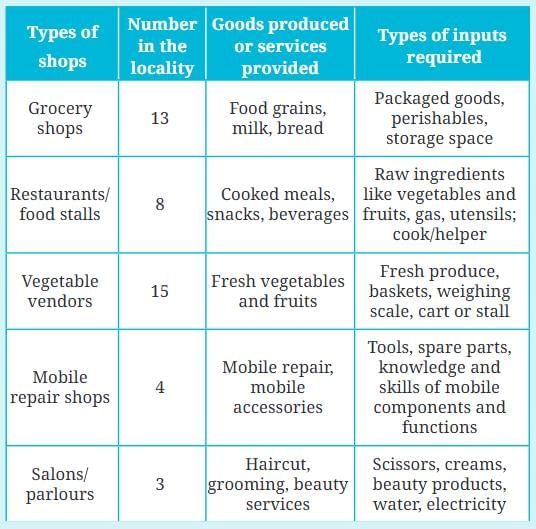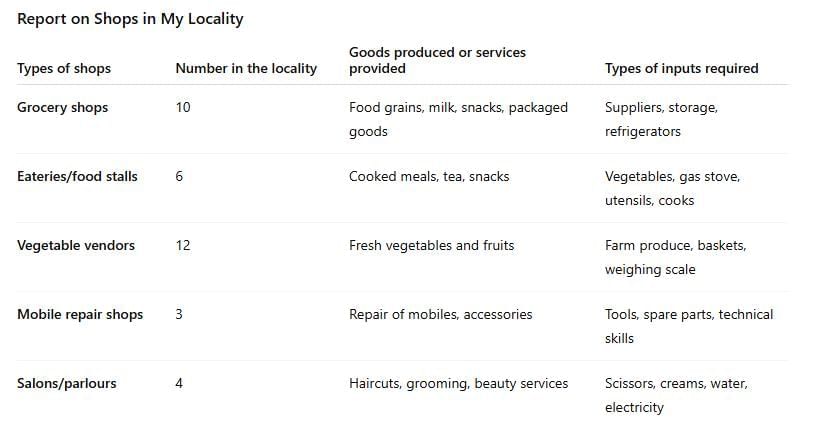Let's Explore: Factors of Production | Social Science Class 8 - New NCERT PDF Download
Page 165: LET’S EXPLORE
Q1. In small groups, study the economic activities around your locality. What are the different types of goods and services being made or provided?
Ans: In my locality, people provide both goods and services. Shops sell groceries, medicines, and clothes, while eateries prepare food. Services include tailoring, repairs, and salons. These activities meet our daily needs.
Q2. Here’s a small report that Latha, Asha, Mohan, and Kiran made. You can make your own report for shops of your choice.

Ans: These shops show how people in our locality provide a mix of goods and services using different inputs, meeting the community’s daily needs
Q3. Looking at your group’s report, think about the following:
- Where do people get the money that they need for their business?
Business funding comes from personal savings, loans from family or friends, bank loans, or government schemes and cooperatives—helping them kickstart their ventures! - Where did the hairdresser get trained? Who taught the food vendors to cook?
Hairdressers often train through apprenticeships with experienced barbers, vocational institutes, or informal learning at home and workshops. Food vendors learn cooking from family traditions, self-practice over time, or sometimes formal cooking classes. - What motivated the business owners to start their business?
Motivation includes earning a livelihood, seeking independence, using their unique skills and passions, or fulfilling community needs—like Ratna’s tasty meals for travelers!
Page 166: LET’S EXPLORE
Revisit the table in your report. Which of the items on your list can be labelled as ‘land’?
From the table, items that can be labelled as ‘land’are:
- Farmland used to grow vegetables and fruits (for vendors and eateries).
- Water used in food stalls, restaurants, and salons.
- Shop space/land where grocery shops, repair shops, and salons are located.
- Natural resources like soil, sunlight, and fuel that support these activities.
- So, all natural resources and physical space used in production are part of ‘land’.
Page 168: THINK ABOUT IT
How do infrastructure and healthcare systems contribute to developing human capital?
Ans:
- Hospitals and healthcare keep people fit, reducing sick days and boosting focus.
- Doctors, labs, and pharmacies ensure timely care, while healthy students attend school regularly to learn.
- Healthy workers bring creativity and productivity, enhancing human capital’s overall quality!
Page 169: LET’S EXPLORE
Q1. Let’s do a small experiment. Make a list of 10 working adults in your family and neighbourhood. Ask them to describe the culture at their workplace. Share notes with your classmates. What did you discover? What are some adjectives that occur more frequently?
Ans:
- My list includes a teacher, shopkeeper, nurse, driver, office clerk, farmer, tailor, doctor, mechanic, and bank teller. They described their workplaces: the teacher praised teamwork and support, the shopkeeper highlighted hard work and customer care, the nurse noted discipline and compassion, and others mentioned cooperation or pressure.
- Sharing notes, we discovered workplaces value collaboration, effort, and care, though some face stress. Frequent adjectives: ‘hardworking’, ‘cooperative’, ‘disciplined’, and ‘friendly’—showing a blend of dedication and unity.
Q2. In the Tapestry chapters, you have seen examples of the art and architecture in India across several centuries. What do you think are the factors that enabled their creators to achieve such high levels of excellence? Discuss in groups and share in class.
Ans: In our group, we think excellence came from skilled training passed down by masters, deep cultural and spiritual inspiration (seeing work as devotion), precise use of math and science in designs, generous royal patronage, and years of patient effort. Examples like the Taj Mahal or Khajuraho temples show how dedication and community support crafted such wonders—let’s share these ideas in class!
Page 170: THINK ABOUT IT
Q1. Shivay, a student at Saraswati Vidyalaya in Grade 8, had to drop out of school two years back as his father lost his job. How do you think the loss of schooling years will affect Shivay when he grows up?
Ans: Shivay’s dropout might limit his skills and job options, lowering his future income and confidence while reducing social mobility.
Q2. What problems could businesses face when they do not find workers with the required skills?
Ans:
- Businesses face poor-quality output, lower productivity, higher training costs, and struggles to compete without skilled workers.
- No job is more important—cleaners keep streets safe, farmers feed us, doctors heal; if any stop, life falters. Every role keeps society balanced!
Q3. Are some jobs more important than others? What would happen if nobody cleaned the streets, collected the trash, farmers stopped cultivating the crops, doctors were not available to treat patients, and so on?
Ans:
- No job is more important—every role keeps society running! Cleaners keep streets safe and healthy, trash collectors prevent disease, farmers grow our food, and doctors save lives. Each is vital like puzzle pieces.
- If these jobs stopped, streets would get dirty and spread illness, trash would pile up causing health hazards, no crops would mean hunger, and no doctors would lead to untreated sicknesses—chaos would follow, showing how every job matters!
Page 172: LET’S EXPLORE
Q1. Many of the traditional techniques of production have either disappeared or are on a decline. For example, the stitching of ships saw a severe decline after the arrival of Europeans in the Indian Ocean in the 16th century. This technique is now used for small fishing boats.
Ans: It’s interesting how the stitched ship technique, once vital for trade, faded with European influence. Now it’s mostly for small fishing boats—showing how traditions adapt to modern needs!
Q2. Why do you think the use of indigenous techniques has declined? Discuss in the class.
Ans: I think indigenous techniques declined because modern machinery is faster and cheaper, like metal ships replacing stitched ones. Also, colonial rule pushed foreign methods, and younger generations prefer new tech over old skills. In class, we could discuss how globalization and lack of training also play a role—maybe we can find ways to revive them!
Q3. Find out some techniques and products from your region that showcase human effort and skill. Explain briefly using drawings and text in the class.
Ans:
In my region (e.g., Punjab), I’d highlight handwoven phulkari embroidery—women stitch colorful floral patterns on cloth with thread, showing patience and artistry. Another is traditional clay pottery, where potters shape pots on wheels with skilled hands. I’d draw a woman stitching phulkari with vibrant threads and a potter at a wheel, explaining how these crafts reflect local culture and effort—let’s share in class!
Page 173: LET’S EXPLORE
Identify a factory in your region. Find out how much capital may have been invested in the construction of the factory (you may provide an estimate). What kinds of equipment does the factory use to create its finished products?
Ans:
- In my region, let’s say there’s a textile factory in Surat (a known textile hub). I’d estimate the capital invested in construction around ₹50-100 crore, considering land, buildings, and setup costs for a medium-sized unit.
- The factory likely uses equipment like spinning machines, looms for weaving, dyeing units, and cutting/sewing machines to produce finished fabrics or garments. These tools combine skill and technology to create high-quality products!
Page 175: THINK ABOUT IT
- What could be the lessons for young entrepreneurs that you can gather from the above case?
- Does the existing knowledge of the entrepreneur help in finding solutions to the problem at hand? Or do they need to seek other sources?
- Is profit the only motivation for an entrepreneur? Why or why not?
- What are the other personality traits required to be a successful entrepreneur?
Ans:
- Lessons: Dream big with vision, be honest, care for workers, balance profit with social good, and innovate like starting airlines.
- Existing knowledge helps as a foundation, but adapting with new sources is key to solving problems.
- Profit isn’t the only goal—entrepreneurs also aim to solve issues, create jobs, and serve society, though profit sustains them.
- Success needs risk-taking, creativity, leadership, perseverance, and resilience to overcome challenges!
Page 178: LET’S EXPLORE
Q1. Can you think of some technological advancements that have impacted the lives of people and communities around you? Talk to elders at home and in the neighbourhood about it.
Ans:
- Some advancements I’ve noticed include smartphones for instant communication, UPI for quick digital payments, and solar panels for eco-friendly power—making life easier! I spoke to my grandpa, who said life before mobiles meant waiting days for letters, and a neighbor mentioned how tractors replaced oxen in farming, saving time.
- These changes connect people, boost business, and help farmers, showing how technology shapes our community—let’s share more stories in class!
Q2. Think of an invention that you would like to make to solve a problem. Write its related information on a piece of paper, such as its name, what it does, and how it works, sketches or drawings of what it would look like, and so on. Discuss with your classmates.
Ans:
- My invention is the ‘WaterSaver Sprinkler’—it solves water wastage in gardens. It uses sensors to detect soil moisture and sprinkles only when needed, saving water with a timer. I’d sketch a small, green device with a sensor on top and pipes below, powered by a solar panel.
- I’d love to discuss with classmates how it could help during dry seasons and get their ideas to improve it!
|
31 videos|128 docs|7 tests
|
FAQs on Let's Explore: Factors of Production - Social Science Class 8 - New NCERT
| 1. What are the main factors of production? |  |
| 2. How does land contribute to production? |  |
| 3. Why is labor considered an important factor of production? |  |
| 4. What role does capital play in the production process? |  |
| 5. How does entrepreneurship influence the factors of production? |  |
















